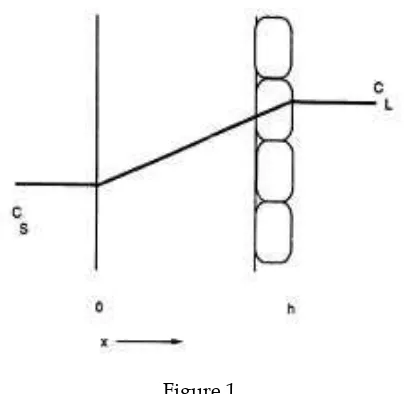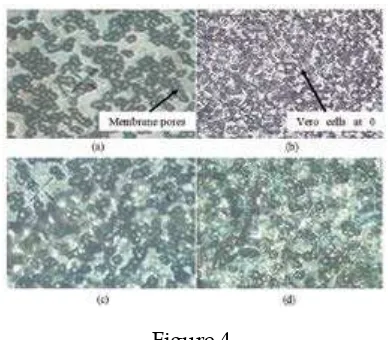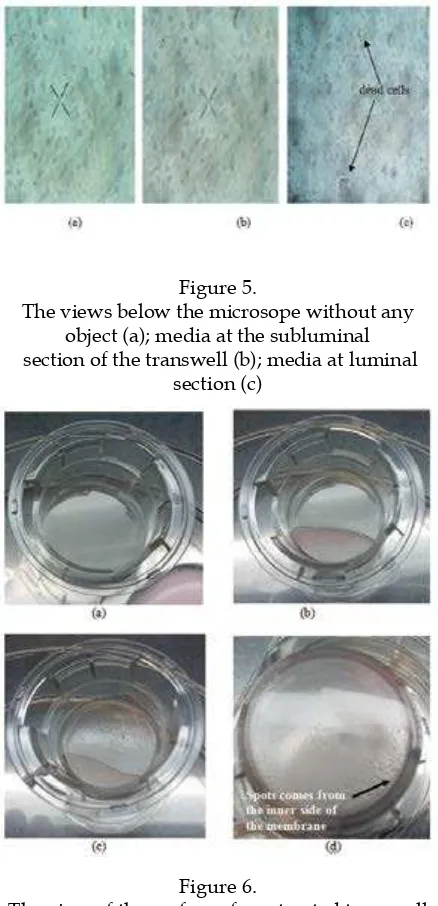VOLUME 6 No. 1, 22 Desember 2016 Halaman 1-58
rOLE Of rEDUCING CELL LEaKaGE IN CELL CULtUrE
UsING LarGE POrE sIzE PErMEaBLE MEMBraNE
Nur Kaliwantoro
Mechanical Engineering Department Engineering Faculty- Mataram University
Email: kaliwantoro@gmail.com
Marsetyawan HNE Soesatyo
Histology and Cells Biology Department-Medical Faculty Universitas Gadjah Mada
Indarto
Mechanical Engineering Department, Engineering Faculty Universitas Gadjah Mada
Mohammad Juffrie
Pediatric Department, Medical Faculty Universitas Gadjah Mada
Rini Dharmastiti
Industrial Engineering Department, Engineering Faculty Universitas Gadjah Mada
Suprihatin
Parasitology Laboratory, Medical Faculty Universitas Gadjah Mada
aBstraK
Membran permeable banyak dipergunakan dalam penelitian in vitro kultur sel. Kebocoran sel sangat sering terjadi ketika membran permeabel yang dipergunakan memiliki ukuran pori-pori yang relatif besar. Di sisi lain, pemakaian membran permeable dengan pori-pori yang lebih kecil pada studi permabilitas banyak menghadapi kesulitan teknis akibat kecilnya ukuran pori dan densitas pori-pori membran. Penelitian ini menghadirkan teknik memperkecil kebocoran sel pada kultur sel yang mempergunakan membran permabel berpori-pori besar. Vero cell line (CCL-81, ATCC) dipergunakan sebagai sel objek dan dikultur pada membran polyester yang memiliki ukuran pori 3 µm. Visualisasi dengan bantuan mikroskop dipergunakan untuk menganalisa kebocoran sel. Adapun untuk menguji kinerja permeabilitas sel dipergunakan parallel
plate low chamber. Hasil penelitian mendapatkan bahwa temuan teknik yang dipakai mampu menurunkan kebocoran sel secara signiikan pada kultur sel dengan membran permeabel berpori-pori besar. Hasil yang
sama juga dijumpai pada pemakaian membran permeabel yang terbuat dari polyester dan polycarbonat.
Kata Kunci: Kebocoran sel; Membran permeabel; Parallel plate low chamber; Sel vero; Ukuran pori.
aBstraCt
size in permeability studies faces some difficulties due to its small pore size and pore density. Recent study provides the protocol in using permeable membrane with large pore size with smaller cell leakage. Vero cell line (CCL-81, ATCC) was used and culture on polyester permeable membrane with 3 µm pore size. Visualization using inverted microscope was used to analized the cell leakage on the permeable membrane. Parallel plate flow chamber was used to analized the permeability performance of the Vero cell cultured on the permeable membrane. The result showed that the current technique is significant in reducing cell leakage of the cell cultured on large pore size of permeable membrane. The same results were found in using polyester and polycarbonate permeable membrane.
Keywords: Cell leakage; Parallel plate low chamber; Permeable membrane; Pore size; Vero cells.
INtrODUCtION
The use of permeable membrane as cells attachment are widely used in the study of drug transport, chemotaxis, cell-cell communi-cation and pathology of several diseases with the change of permeability like dengue
infec-tion, Rickettsia and inlammation (Corning,
2010).
One type of permeable membrane avail-abled commercially is the polyester permeable membrane. This type of permeable membrane has better visibility under phase contrast mi-croscope compared to polycarbonate mem-brane. General recommended poresize for the permeability studies are 0.4, 1 and 3 µm (Corn-ing,2010). But the use of 0.4 µm poresize of polyester for studies the permeability is very hard due to its small pore size and number of pore density (4.106), compared to
polycarbon-ate with the same pore size that has 1.108 pore
density. In another hand, the use of Polyester transwell permeable membrane with 3 µm pore size causes a lot of cell leakage. Unlike the PC membrane, the Polyester membrane with pore size of 1 µm are not available commercially.
Previous studies of permeability com-monly used the Polycarbonate membrane with 0.4 µm (Casnocha, 1990; Wahyudi, 2006), but the use of Polycarbonate membrane gives
dif-iculties in monitoring the cell growth on the
membrane due to its invisibility. Cell leakage using 3 µm pore size were also reported in the
studies using Polycarbonate membrane (Cas-nocha, 1990).
In the permeability study, the governing principle for one dimensional mass transport
of species A in species B is Fick’s irst law of
diffusion:
Where JAx = mass lux of A in the x-direc -tion; DAB = diffusion coeficient of A in B; dCA/ dx = concentration gradient of A
Figure 1.
A cross section of the membrane-monolayer composite showing the system geometry and
concentration proile (Casnocha, 1990)
In case of transwell having luminal and
sublimal section, the permeability is deined as:
Where PC = permeability coeficient, JAX=
Mass lux across permeable membrane, CL = concentration of luminal section, Cs = concen-tration of subluminal section, ρ = density of species A, V = volume of species A.
In the cell culture using large pore size, the permeability can also be analized using
Based on previous problems, recent study gives the protocol in using permeable mem-brane with 3 µm pore size with small number of cell leakage as well as the performance of permeability using large poresize permeable membrane.
Material and Method
Vero cell line (CCL-81, ATCC) were pro-vided at the Parasitology Laboratory, Medical Faculty of Gadjah Mada University, Indonesia. 24 mm transwell polyester permeable mem-brane with 3 µm were supplied by Corning (cat. 3452). Culture media M199 and FBS were supplied by Gibco. 10 cm petridishes were supplied by Iwaki. Parallel plate low chamber used in permeability test was manufactured based on previous research.
reducing Cell Leakage in Culturing
using Large Pore size Permeable
Membrane
Vero cell line was harvested, centrifuged and put the pellet into a falcon tube. Added some complete media contains M199 and FBS until the cell density reach 1.000.000 cells/ ml. Four 24 mm transwell polyester transwell (PET) permeable membrane with 3 µm were carefully put on two 10 cm petridishes (each petridish contains 2 transwell PET). Carefully pipetting 250 µl of media contains vero cell into each PET permeable membrane. Added 750 µl of complete M199 media into each PET tran-swell permeable membrane. Put the lid of the petridish in such away that the lid of the petri press the bottom of the permeable membrane on the base of the petridish. The petridish was sent into the CO2 incubator for 48 hours. After that, a 6 well plate was prepared by pouring 500 µl of M199 media into each well. The old media in each transwell that put in the pe-tridish for 48 h in the CO2 incubator was re-moved. Each transwell was then put into the 6 well plate. After that, 1000 µl of M199 media was put into each PET transwell. The 6 well plate that contains PET membrane was then sent back into the CO2 incubator. The complete media was replaced each 3 days until the cell reach its monolayer.
Cell Leakage test
Cell leakage was analysed by visualiza-tion using inverted microscope on the petridish surface below the transwell permeable mem-brane. The bottom surface of the transwell was also analysed using inverted microscope, and compared to original condition of the transwell that has not used in the culture.
Permeability test
The method of transwell experiment
ad-opted in the recent work was a modiication
from the method reported by Yen et al (2008) and Casnocha (1990).
Vero cells were grown to conluent mono -layer in the upper chamber of polycarbonate membrane transwell by seeding at 2 x 106 cells/
cm2 and incubated for 72 hours. Trypan
blue-labeled bovine serum albumin was prepared by adding 180 mg trypan blue (Sigma) and 4 g bovine serum albumin fraction V (Sigma) to 100 ml Hanks balanced solution (Gibco) and precipitated with 5% tricholoroacetic acid. Try-pan blue-stained bovine serum albumin was
lowed to the upper chamber of the transwell.
After the medium low for 30 minutes, the luid in the lower chamber was picked for 2 x 10 ml.
Then, the luid was stirred to homogenized the
albumin and the serum. 2 ml of this homoge-nized albumin-serum was analysed using mi-croscope to determine the amount of albumin across the vero cells. The transwell membrane with vero cells were then removed to be visual-ized using inverted microscope.
rEsULt aND DIsCUssION
reducing Cell Leakage in Culturing
using Large Pore size Permeable
Membrane
no more than twice when the transwell was placed in the petri dish. On the third day, the cell was assumed to have been grown stable, attached tightly on the permeable membrane, and then the transwell were removed to 6 well plate as shown in Figure 3.
Figure 2.
Vero cells cultured on the transwell permeable membrane were put on to petridish and closed tightly using their lids to reduced cells leakage
across the membrane
Figure 3.
At the third day, the transwell were moved into 6 wells plate. Fluid in the petridish was the media leakage from thecell culture when the transwell was placed in the petridish for 48 hours. Fluid in the 24 wells plate came from
the remained luid in the luminal section of the
transwell permeable membrane.
One of the big dificulties in the culturing
cell on the permeable membrane was the determination whether the cell culture have
reached conluency without destroy the
cells. It appeared since the shape of the cell before seeding almost the same with the shape of membrane pores. Recent study used microscope to visualize the cell growth on the membrane. As shown in Figure 4,a, the membrane pores have perfectly circular shape, while the cells’ shape were not perfectly circular and slight
larger than the pores (Figure. 4,b). By the time the cells grew up and the shape became larger and covered the permeable membrane as well as its pores (Fig. 4.c and Fig. 4.d).
Figure 4.
Permeable membrane without cells (a), Vero cell seeding on the permeable membrane at 0 hour (b); vero cell culture after 24 hours (c)
and 48 hours post seeding (d)
The modiied procedure has been proven
to be effective in preventing the cell migration across the relatively large size permeable mem-brane as shown by Figure 5 (a) – (c). At those
igure it is seen that the media at the sublumi -nal section almost free of cells, which indicat-ed only a little amount of cells could migrate across the permeable membrane. Such condi-tion could be achieved since the transwell was pressed tightly enough on to the surface of the petri dish using its lid.
A more proof of the effectiveness of the
modiied technique in preventing cell leakage
Figure 5.
The views below the microsope without any object (a); media at the subluminal section of the transwell (b); media at luminal
section (c)
Figure 6.
The view of the surface of pre-treated transwell (a); the surface of the transwell wetted by media containing no cells (b); the surface of the transwell that has been cultured by vero cells (c),
the surface of the bottom side membrane (d)
Permeability
In this study, the performance of perme-ability under dynamic condition was analysed using parallel plate low chamber made from acrylic material. The system built the this work is not employed any roller nor syringe pump as used by previuous research (Casnocha, 1990, Arslan, 2010), but fully uses the gravitation for
lowing the culture media in the lining. The
luid capacity enters the system is controlled
using a regulator in the pediatric infusion set. Since the diameter in the line of pediatric infu-sion is small, and the viscosity of the culture media analysed in this works has values up to 1,33 mm2/s, then the media sink must be
low-ered irst in each operation to trigger the luid lowing in the whole line of the system.
Figure 7.
Parallel plate low chamber built in the recent
study used permeable membrane for growing cells, also used pediatric infusion set to get a
small luid capacity as low as 1ml/minute
In the performace test of the permeabil-ity using parallel plate low chamber, it was found that the permeability of the membranes that had been pre-treated in the petridish, 20% lower than those without any prea-treated in the petridish. It is indicated that the cell culture in the membrane with pre-treated more
con-luent and less cell leakage than the membrane without any pre-treated.
CONCLUsION
Cell leakage in the cell culture using large pore size permeable membrane can be reduced using the procedure explained in this study. The permeability of the permeable membrane under dynamic condition can be analysed us-ing parallel plate low chamber
rEfErENCEs
Arslan N, Isik S, Uykan O, 2010, “Steady
and disturbed low effects on
Bioengineering and Biomechanics, 12 (4): 3-9.
Casnocha, 1990, “Permeability of endothelial monolayers under stationary
and low condition”, Dissertation, Michigan University, USA.
Corning, 2010, Corning Cell Culture Selection Guide.
Wahyudi, 2006, “Pengaruh Shear Stress terhadap sintesa dan release Nox
dari HUVEC yang dipapar dengan
Glukosa Supraisiologis”,Disertasi, Universitas Brawijaya.


